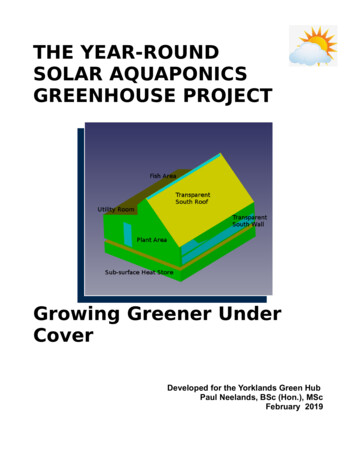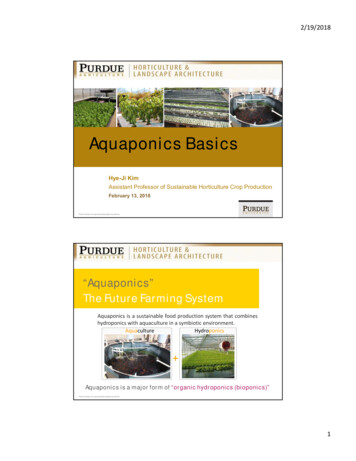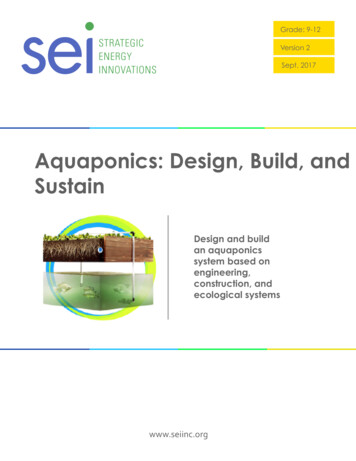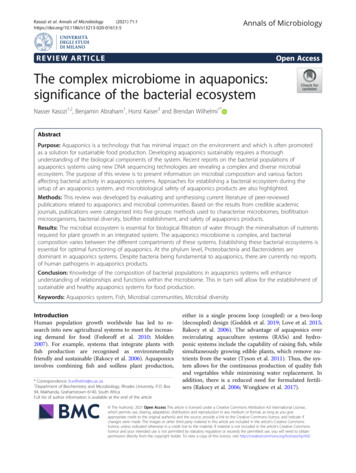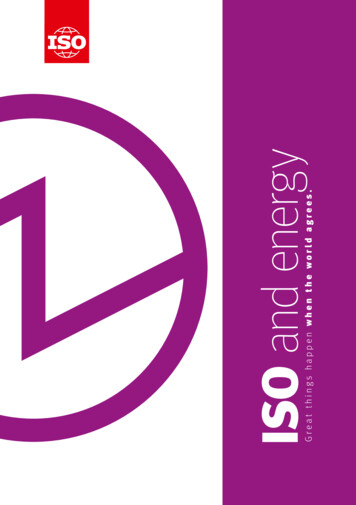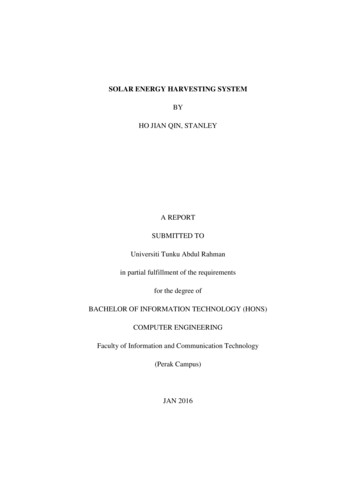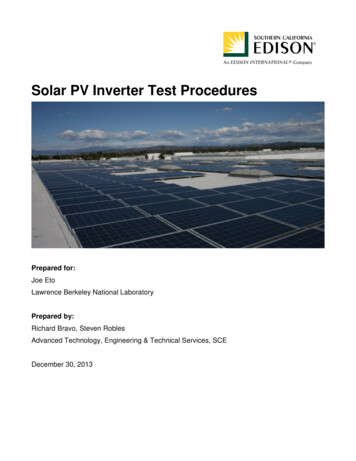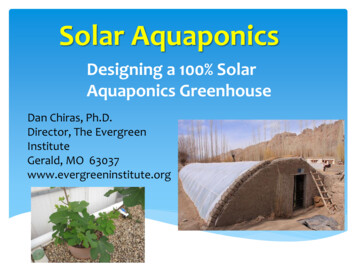
Transcription
Solar AquaponicsDesigning a 100% SolarAquaponics GreenhouseDan Chiras, Ph.D.Director, The EvergreenInstituteGerald, MO 63037www.evergreeninstitute.org
Topics Creating a 100% solar operation Efficiency First! Solar electricity – lighting, water pumps,and aeration Not resistive heating! Solar thermal – heating water Passive solar heating and cooling
UnderstandingSolar Energy
The Sun Earth orbits around the sun Completing its path every365 days Earth’s orbit is elliptical Distance from the Sunvaries Earth is closest to the Sunduring the winter Farthest from the Sun inthe summer
Understanding Solar EnergyFrom Jim Dunlop, Photovoltaic Systems, ATP
From Jim Dunlop, Photovoltaic Systems, ATP
From Jim Dunlop, Photovoltaic Systems, ATP
The Sun’s Path Position of the Sun changes during the year As a result of the changing relationshipbetween the Earth and the Sun Sun “carves” a high path across the summersky Reaches its highest point on June 21 June 21 longest day of the year Aka the Summer Solstice Sun carves a low path across the sky onDecember 21 Shortest day of the year Winter Solstice
Solar Window
Solar Electricity
Solar Electricity -- PhotovoltaicsPhoto sunlightVoltaics electricity
PV cells, modules, and array
How to go solar Lots of options Easiest of all Install a PV system onyour home Simply plug in If aquaponics system ison its own meter Can install a PV systemto supply it Wire it into the panel Add batteries forbackup
Types of Systems Grid Connected Grid-Connected with Battery Backup Off-grid or Stand Alone
Grid-Connected PVSystem
When the grid goes downso does your system!
Grid-tied with battery backup
Off-Grid or Stand Alone
Mounting options Ground Building—typically roof
Courtesy Rochester Solar Technologies
Orientation of Solar Modules For maximum output Solar modules should beperpendicular to the sunfrom sunrise to sunset This is possible with atracker For fixed array, arrayshould be pointed truesouth Not magnetic south
True south and magnetic south rarelycoincide
Dedicated PV System for AquaponicsPV ModulesCharge ControllerBatteryInverterAir PumpWater PumpLights
Will this work?45-watt systemNeed to purchasbattery and 300inverter
How to Size a System Determine the size of the PV system Add up wattages of pumps Multiply each one by hours in use per day To determine watt-hours Convert to kWh per day Air pump -- 20 watts Water pump -- 40 watts Both run 24 hours per day
How to Size a System Total 60 watts 60 watts x 24 hours per day 1,440 watt-hours per day 1000 watt-hours 1 kWh 1.44 kWh per day Multiply by 365 for annual use 1.44 x 365 526 kWh per year
How to Size a System 1 kW system in Colorado 5.7 peak sun hours per day X 365 days X 0.78 efficiency factor 5.7 x 365 2080 2080 x 0.78 1,622 kWh per year Unshaded array Orientation -- true south
How to Size a System 526 divided by 1,622 about a 0.32 kW system A 320-watt system for air and water pumps Most modules these days around 250 to 260watts So may need 2 modules Cost about 1/watt or 250 each Harbor freight 45-watt array is not going tosuffice Then you need to size the battery to holdelectricity Why? Night time function Power outages
How to Size a System Size battery bank for three days of battery-onlyoperation 60 watts x 24 hours 1.44 kWh per day 3 x 1.44 4.32 kWh Can’t discharge batteries more than 50% Need to double battery size Need 8.64 kWh of storage Four large solar batteries Cost of 400 each
Heating Water in Aquaponics Heating water can be a huge challenge Resistive heaters consume lots of electricity Water heater element – 4,500 watts to 5,500watts Run 4,500 watt heater 8 hours a day in cold weather 36 kWh per day – roughly 3.60 per day perheating element Won’t need that year round But maybe for three to six months Advice Move South!
Heating Water in Aquaponics Smaller systemTank heater – 400 watts8 hours a day3.2 kWh per day per heaterMay not need that much electricity yearround If you did, you’d need 1,168 kWh per year You’d require a 0.7 kW system Small solar system (approximately 1 kW)on your house would power your heaterand your pumps
Heating Water in Aquaponics Suggestions For existing systems Improve efficiency – reduce the loss of heat from tanksand grow beds New systems – build them right! Insulate tanks and grow beds Insulate pipes, especially if they run through a concreteslab Starting new: Build a superefficient greenhouse that isthermally stable and hence provides most of the heat forthe water! Provide heat via a solar hot water or solar thermalsystem
Types of DSHW Systems Two types of systems -- active and passive Components – solar collector and storagetank Often linked to conventional storage waterheater or on-demand (tankless) water heater
Solar Batch Water Heater
Integrated collector-storagesystemPassive system – nopumps, operates on linepressure
Opensystem
Progressive Tube Solar Water Heater30, 40, and 60 galloncapacity
Progressive Tube Solar Water Heater Provide 100% of hot water on sunny daysPreheat water on cloudy daysReduce fuel use and utility billFairly inexpensiveFairly easy to installNo pumpsNo electricityNo sensors or costly controlsLittle or no maintenanceHeavy – be sure roof can support load
Progressive Tube Solar Water Heater Suitable for use in warm,sunny climates Not suitable for coldclimates Can also use for domestichot water
Active Systems -- PumpCirculation systems
Pump-Circulation systems Separate storage and collectionCollector on the roofStorage tank located inside the houseAdvantage: reduces heat loss from storage tank atnight Two common options drainback (water heat exchange fluid) glycol (propylene glycol heat exchange fluid)
Solar Hot Water Drainback System Active system -pump driven Heat exchange fluid water Closed system Designed for areaswhere freezingoccursCourtesy of Home Power Magazine
Solar Hot Water Design IdeasBackupheatingelementSolar CollectorSolar hot waterstorage tankControllerTemp.sensorPumpFish TankHeatExchanger
Solar Greenhouse
Passive Solar Heating and Cooling Proper orientation and design of greenhouse Cooler in the summer Warmer in the winterDesign all wrong Most greenhouses are spacious, uninsulated Too much volume No thermal mass Wide temperature swings year round Vent heat even in the winter Lots of energy to heat and cool them
Passive Solar Heating and Cooling We tend to use technology developed in Holland Large greenhouses Massive volume Single-pane glass Burn lots of wood, natural gas, coal, or oil to heat Then vent and cool in the summer Amount of fuel needed Exceeds amount needed to transport equivalentamount of produce from regions where it’s inseason
Design Like a Solar Home Design to capture winter sun Plenty of sun in summer Orient greenhouse on an east-west axis No glass on north side Minimize or eliminate glazing on east andwest sides Insulate north side Better yet, earth shelter and insulate on northside Provide thermal mass Double-pane glass or double plastic
How do we solve these issues? In winter, store excess heat during dayrather than vent Use stored heat at night in winter Produce heat Passively May also supplement with solar thermalsystem Store summer heat for use in winter Tricky but can be done
How do we solve these issues? Even larger challenge Store summer heat For use in winter Tricky but can be done Underground storage Sand beds Water storage tanks Ground beneath or around the greenhouse Draw that heat off during the winter
How do we solve these issues? Sound impossible? Consider the Chinese Greenhouse Passive solar greenhouses in China No supplemental lighting Little or no supplemental heating Produce vegetables through Fall, Winter, andSpring
How do we solve these issues? Chinese greenhouse Developed in mid-1980s Highly evolvedtechnology In 2000, covered 650,000acres No current estimate Virtually unknown inNorth America
Secrets of Success of Chinese SolarGreenhouses Long axis oriented East-West Not North-South Low-profile greenhouse Minimize surface area forwinter heat loss 30 to 46 feet wide Not all glass design Thick insulated back wall and partial roof Back wall contains thermalmass
Secrets of Success Large interior thermal mass Conventional greenhouse soil, floors, andback walls In aquaponics systems – floors, back wall, andwater
Solar Window
Design Features Arched struts (beams) Up to 12 meters (39.6 feet) Single layer of plastic Could be improved by applying a doublelayer Thermal blanket to insulate at night
Temperature Inside and Outside ChineseGreenhouse in Shenyang, ChinaTemperatures were10 to 15oC (18-27oF)warmer
Temperature inside and outside a Chinese StyleGreenhouse in Manitoba, CanadaTemperatures were 10 to30oC (54oF) warmer
Design for heat retention You wouldn’t live in a greenhouse Because of wide temperature swings So how can our plants and fish? Redesign – Chinese Style Create heat storage for winter day-nightcycling Underground heat storage for summer towinter heat storage Surplus summer heat pumped underground Released in winter
Design for heat retention Also earth shelter greenhouse Keep it cooler in the summer and Warmer in the winter Or consider Hoop houses over grow beds Underground heat storage Solar thermal heat storage
For Additional Information
For Additional Information
For Additional Information
Let the Sun Shine in! Dan Chiras, Ph.D. The Evergreen Institute www.evergreeninstitute.org danchiras@evergreeninstitute.org (720) 273-9556
Smaller system Tank heater – 400 watts 8 hours a day 3.2 kWh per day per heater May not need that much electricity year round If you did, you’d need 1,168 kWh per year You’d require a 0.7 kW system Small solar system (approximately 1 kW) on your house would power your heater an
